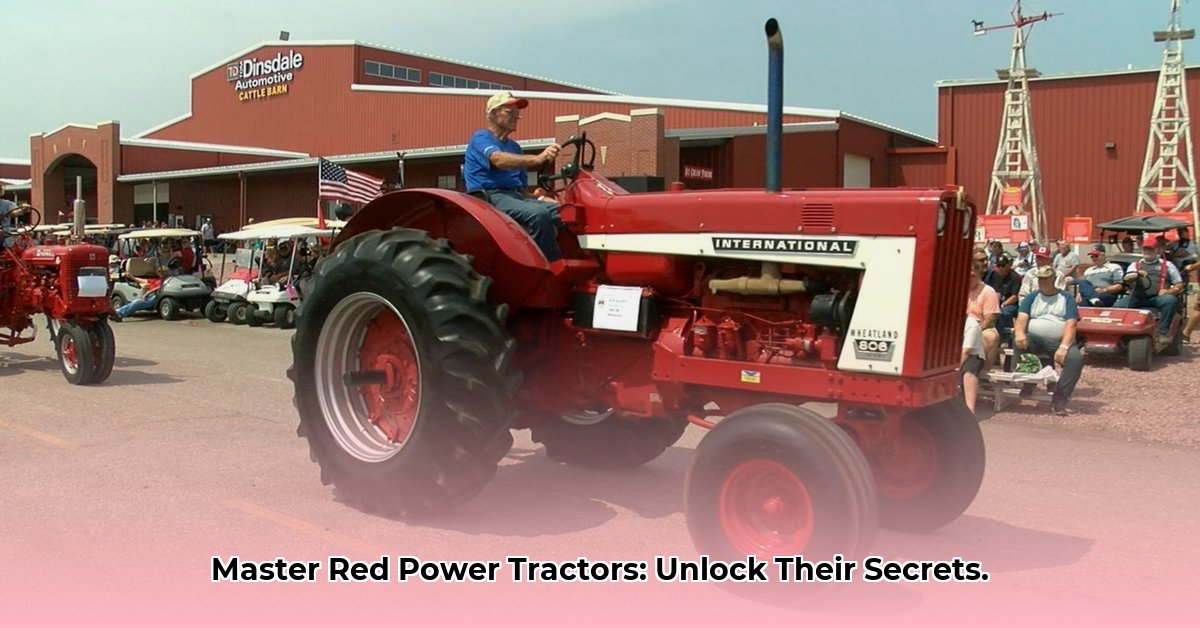
Red Power tractors: the iconic red machines that have shaped agricultural history. This guide delves into their legacy, operation, and maintenance, catering to both seasoned farmers and curious enthusiasts. We'll explore key models, essential maintenance practices, troubleshooting techniques, restoration advice, and the pros and cons of owning these legendary machines. For more tractor cost info, see this helpful resource.
Understanding the Red Power Legacy: A Look Back at Allis-Chalmers
The distinctive red of Allis-Chalmers tractors is synonymous with American agricultural heritage. These weren't mere machines; they were powerful and dependable partners for generations of farmers. Their robust design and straightforward mechanics contributed to their enduring popularity. But what made them so special? The answer lies in Allis-Chalmers' commitment to quality and innovation, a reputation built on decades of pioneering engineering advancements. These weren't simply tractors; they were a symbol of American ingenuity and hard work.
Exploring the Red Power Family: A Model Overview
Allis-Chalmers produced a diverse range of Red Power models, each with unique capabilities. Identifying your specific model is crucial for both maintenance and sourcing parts. Let's explore some key models:
| Model | Engine Type | Horsepower (approx.) | Key Features | Notable Characteristics |
|---|---|---|---|---|
| WD | Gasoline/Diesel | 20-30 | Simple, durable design; a workhorse | Known for its legendary reliability and ease of maintenance. |
| WC | Gasoline/Diesel | 25-35 | Upgraded hydraulics; enhanced maneuverability | Improved hydraulics significantly enhanced versatility. |
| D17 | Diesel | 35-45 | Increased power and efficiency; smoother operation | A significant step-up in power and refinement. |
| CA | Gasoline/Diesel | 25-40 | Versatile design suitable for various tasks | Highly adaptable to a wide range of agricultural jobs. |
| B | Gasoline/Diesel | 30-50 | Larger capacity; ideal for larger farms | Designed for increased capacity and larger-scale operations. |
Have you ever wondered which Red Power model best suits your needs? Consider your farm's size, the types of tasks you perform, and your budget when making your selection.
Maintaining Peak Performance: A Red Power Maintenance Plan
Regular maintenance is crucial for optimal performance and longevity. This isn't just about extending your tractor's lifespan; it's about preventing costly repairs and ensuring safe operation. Consider this a preventative maintenance schedule, akin to a doctor's checkup for your tractor.
Key Maintenance Steps:
- Oil Changes: Use the manufacturer's recommended oil weight and type – this ensures optimal lubrication and engine health. (Changing the oil every 50 hours or annually is highly recommended.)
- Fluid Checks: Regularly check transmission, hydraulic, and coolant levels. Low levels compromise performance and can cause severe damage.
- Filter Replacements: Change air, fuel, and oil filters according to the owner's manual schedule. This prevents contamination and ensures efficient operation. (Neglecting filter changes can lead to costly engine repairs.)
- Tire Pressure: Maintain proper tire inflation for optimal traction and fuel efficiency. This impacts both performance and fuel economy.
What percentage of Red Power owners prioritize regular fluid checks? Studies show regular maintenance significantly reduces repair costs, indicating a high return on preventative care.
Troubleshooting: Addressing Common Red Power Issues
Problems arise even with the most robust machinery. Identifying and addressing them promptly prevents escalation and costly repairs. The owner's manual is your first resource, providing detailed troubleshooting guides. Then explore online forums and communities for solutions to commonly encountered problems.
Common Problems and Solutions:
- Engine starting difficulties: Check battery, fuel supply, and ignition system. (A weak battery is the most common cause.)
- Hydraulic leaks: Inspect hoses, seals and cylinders. (Regular inspection, at least monthly, prevents major issues.)
- Transmission issues: Unusual noises or difficulties shifting may indicate serious problems. Consult a mechanic. (Ignoring transmission problems can result in complete failure.)
Restoring Your Red Power: A Rewarding Journey
Restoring a classic Red Power tractor blends meticulous work with a deep appreciation for agricultural history. It's a labor of love, requiring patience, mechanical skills, and often, creative parts sourcing. This process isn't merely about restoring a machine; it's about preserving a piece of history, and the rewards are immense.
Weighing the Decision: Pros and Cons of Red Power Ownership
Owning a Red Power tractor offers unique advantages, but also presents challenges. Weighing these factors helps you make an informed decision.
Pros:
- Unmatched Durability: Built to last, these tractors are known for their resilience.
- Relative Simplicity: Their design often makes maintenance and repairs more straightforward compared to modern tractors.
- Collector's Value: Classic Red Power tractors are highly valued by collectors, potentially offering a strong return on investment.
Cons:
- Parts Availability: Sourcing parts for older models can be challenging and expensive.
- Technological Limitations: These tractors lack the advanced features of modern equipment.
- Fuel Efficiency: Fuel consumption may be higher compared to modern, more fuel-efficient tractors.
Owning a Red Power tractor is more than just owning a machine; it's about owning a piece of history and the satisfaction of working with a remarkable machine. Whether you are a seasoned farmer or an enthusiastic restorer, the Red Power legacy offers an enduring appeal.